
by To-Wen Tseng | Feb 12, 2016 | 2016, Family, Kids, North America, To-Wen Tseng, USA, Work, Working Mother, World Motherhood, Younger Children

A Chinese publisher is hiring me to write a biography for a well-known Chinese American doctor and politician. They wanted 300,000 words by the end of this year. I made it clear that it’s not possible. Considering the long-term contracts I already have, my family situation and my daily schedule, the earliest time I can finish the big book will be next May.
They offered me a $3,000 bonus if I could finish the writing the book on their timeline. Wow, $3,000!
I told them, “I’ll think about it.”
That night for some reason my little one was unusually fussy and insisted to sleep with his mommy. I squeezed myself into his toddler bed and accompanied him. After two bed time stories he fell asleep peacefully. I lay there, staring at the ceiling.
Once again I strongly felt how children can slow a mother down on her career progress. If it was three years ago, before we had a kid, producing 300,000 words within ten months would not be a problem for me at all. I am not boasting it, but hey, they didn’t call me “kuài shǒu” (the fast writer) for nothing!
But now, with a little child, if I want to finish 300,000 words in a year, either I’ll be drained or my child will be ignored.
Women certainly have a different work-life balance than men. Several years ago there was a white paper on the Position of Women in Science in Spain that concluded a man with children is four times more likely to become a full professor than a woman with children is.
The white paper emphasized that women who have children are discriminated against simply because they are mothers and not because their job performance is actually different.
Based on my own experience, I believe that is true. I was harassed by my supervisor for pumping at work. Still, there is a lot we can do to fight back when facing discrimination. We can advocate for equal working rights, we can urge our law makers to pass bills that end discrimination against working mothers, we can file law suits against our discriminating employers. I, for one example, took my previous company to court and was happy about the result.
But we cannot fight nature. The nature rule is that women have to spend more time on their children. Mothers have greater childcare responsibilities than fathers. It’s the mother, not the father, that carries the baby for months, is in labor for hours and breastfeeds for months, or even years. And while some may hope for a different division of labor some day, these work-life realities do contribute to the reason why women who are mothers are on slower career tracks than men.
In this case, if I can’t earn that $3,000 bonus, that’s simply because I need to spend time on my child, not at all because I am discriminated against.
I tossed and turned all night long. It’s not that I want the $3,000, but I really want to speed up my career progression, which has been slow ever since I had my child. But do I want to be drained? More than that, do I want to ignore my child for one whole year? Weighing these things in the balance, that $3,000 didn’t seem so important.
In the morning my little one opened his eyes and saw his mommy was still laying by his side. He giggled and touched my face. I made up my mind.
Working mothers probably will never have the perfect answer to work-life balance. It’s our paradox of choice. I just want to try to live more and regret less.
Have you struggled with juggling your career path and your role as a mother? How do you find a balance between work and home life?
This has been an exclusive post for World Moms Blog by To-wen Tseng. She can be found writing at her blog “I’d rather be breastfeeding” and on Facebook and Twitter.
Photo credit to the author.

by Tara Wambugu | Feb 11, 2016 | 2016, Africa, Kenya, Tara Wambugu, World Motherhood
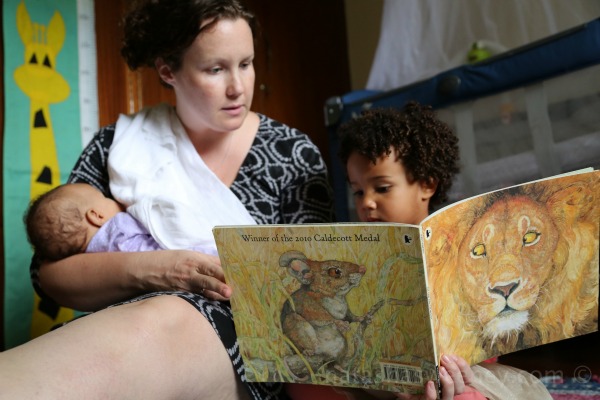
We are big readers in our house, and we have proudly curated a wonderful collection of books for our girls. Both my husband and I want to be sure that our children are strongly exposed to both Kenyan and American culture, so we have made sure we have plenty of books in our collection about life in Kenya and Africa at large. Here are a few of our favorites!
For You are a Kenyan Child, by Kelly Cunnane and Ana Juan
For You are a Kenyan Child is a lovely story about a Kalenjin boy who lives in a rural Kenyan village. He has been given the job of minding his grandfather’s cattle for the day, but he becomes so distracted by all the goings-on in the village that he loses track of the herd. My eldest daughter loves the part when the boy realizes he’s lost track of his grandfather’s cows, and he imagines all the trouble they may have gotten into. I love when he almost knocks down a beautiful Pokot girl and a plump mama carrying mangoes while trying to get back to the grazing cows. Luckily, his wise grandfather knows just where to find them! The illustrations in this book are truly beautiful, and we just love the story.
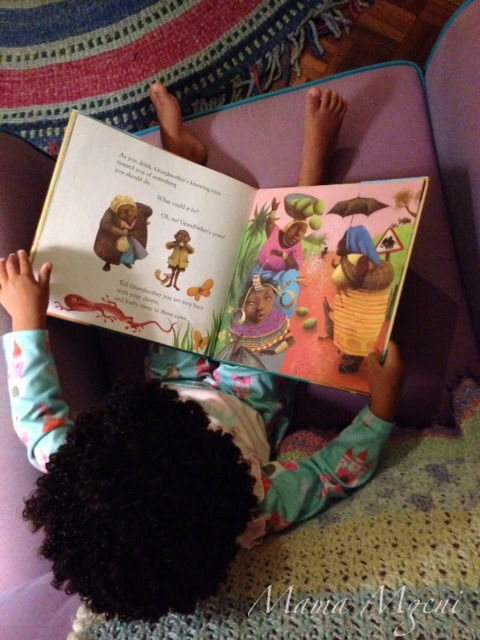
Chirchir is Singing, by Kelly Cunnane and Jude Daly
Chirchir is Singing is the story of Chirchir, a young Kalenjin girl who loves to sing, and wants to help her family with all their work. She tries to help her mother bring water from the well, but drops the bucket. She tries to help her grandmother make the tea, but accidentally puts out the fire. She tries to help her sister mud the floor, but sneezes and makes a mess. Slowly, Chirchir stops singing, and her smile turns to a frown. But soon she finds exactly how she can help, and her family realizes just how wonderful her singing is.
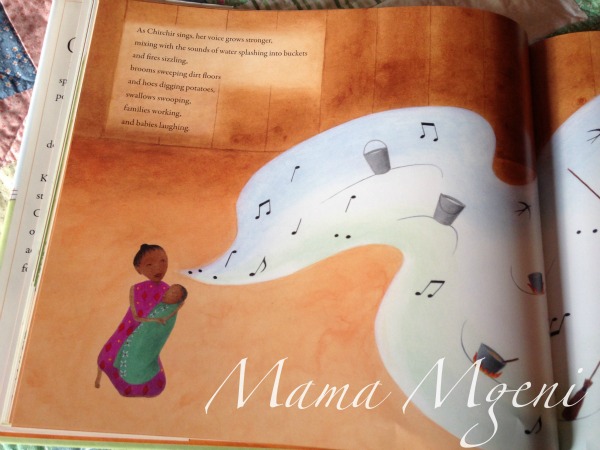
Moja Means One, by Muriel Feelings and Tom Feelings
Moja Means One is a simple Kiswahili counting book, and it’s great for even very young children. It not only teaches children how to count to ten in Kiswahili, but it also describes important African cultural practices, like the way mothers carry their babies on their backs in a simple cloth, the oral tradition of storytelling in the rural villages, and different kinds of traditional African clothing. Both of my children are learning Kiswahili from their father, but it’s so nice to have a book that emphasizes their African heritage!
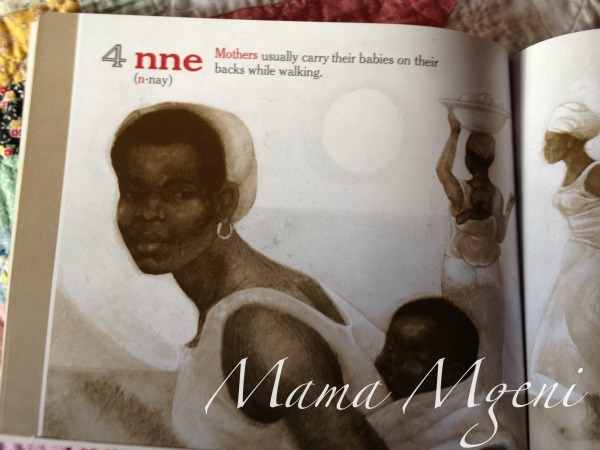
Lila and the Secret of Rain, by David Conway and Jude Daly
This is the story of a young girl in a rural Kenyan village afflicted by drought. The sun beats down on the village, and it is too hot to gather firewood, too hot to weed the garden, and too hot to milk the cow. Young Lila learns from her grandfather the secret of the rain, and she sets out to save her village and bring the rains. She climbs the highest mountain she can find, and begins to tell the sky the saddest things she knew. At last, she laments that without water, there can be no life, and her village is at risk. The sky grows darker, full of Lila’s sadness, and the rain begins to fall. Only Lila and her grandfather know the secret of what brought the rains.
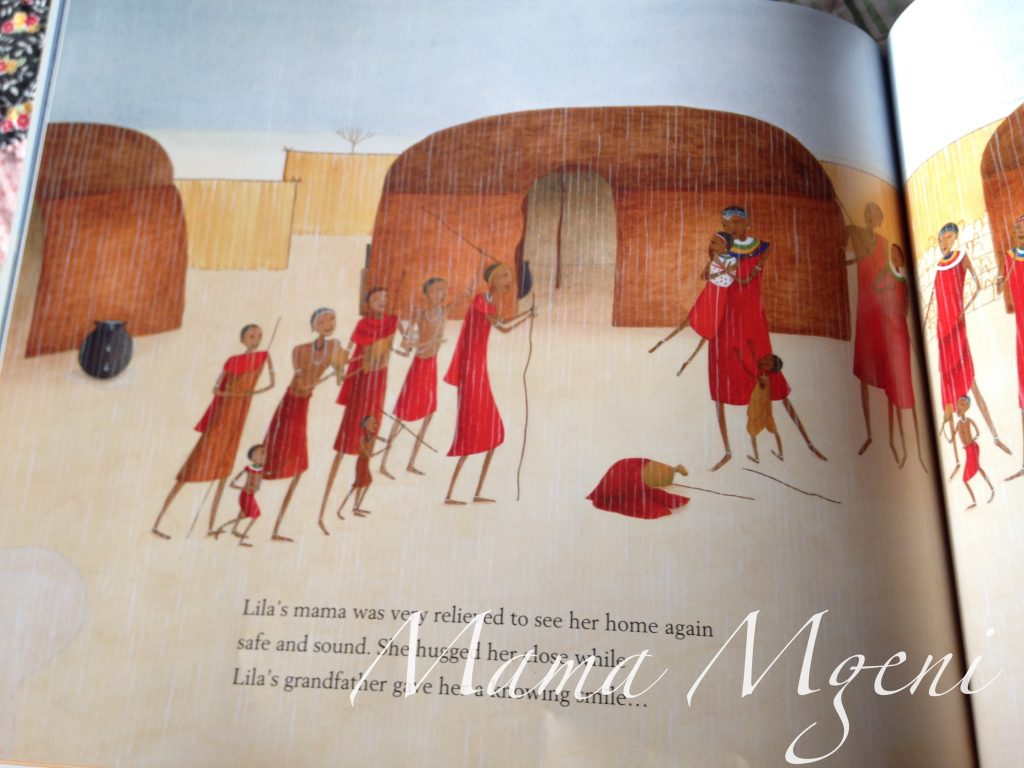
Into the Bush, by Sandra Arensen
Into the Bush is a story is about a young girl named Lilee and her adventures on safari with her family. The tale is vividly told – you can almost hear the sound of the hyenas crunching on bones, or the snap of the crocodile’s jaws in the river below. What I love most about this book are the amazing illustrations. Sandra Arensen does her own artwork using watercolors, and her use of striking lines and vibrant color reminds me of spectacular stained glass windows. My children love the story and the illustrations, and my eldest always talks about her own safari experiences when we read it!
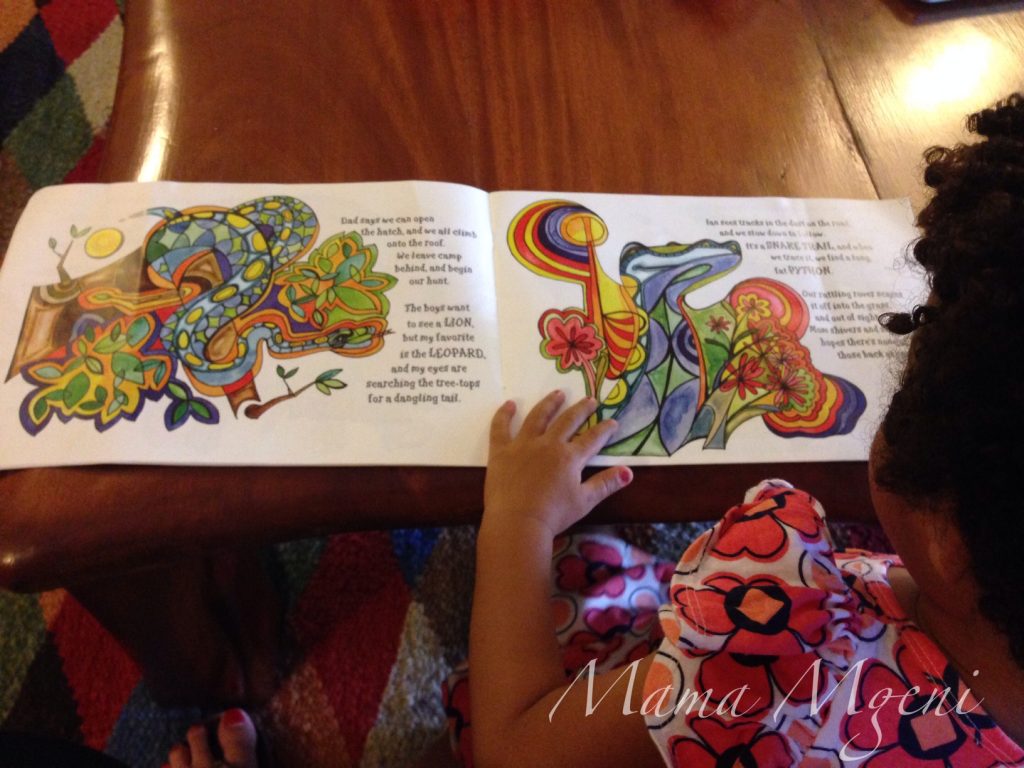
“Into the Bush” isn’t available online, but you can send an email to the publisher at editorial@oldafricamagazine.com, if you are interested in purchasing it. The cost of $10 USD covers the book and shipment in the USA. Please let them know what country you are in, so they can give you the proper pricing!
The Lion and the Mouse, by Jerry Pinkney
Jerry Pinkney illustrated his beautiful adaptation of Aesop’s famous fable about acts of kindness. There are no words in this book – it is up to parents to narrate the story based on the powerful illustrations. We all know the tale: a fierce lion decides to spare the life of a timid field mouse who wakes him from his sleep. Later, the tiny mouse comes to the lion’s rescue, freeing him from a poacher’s net. The moral of the story, of course, is that no good deed goes unrewarded, and that all creatures – great and small – can help one another.
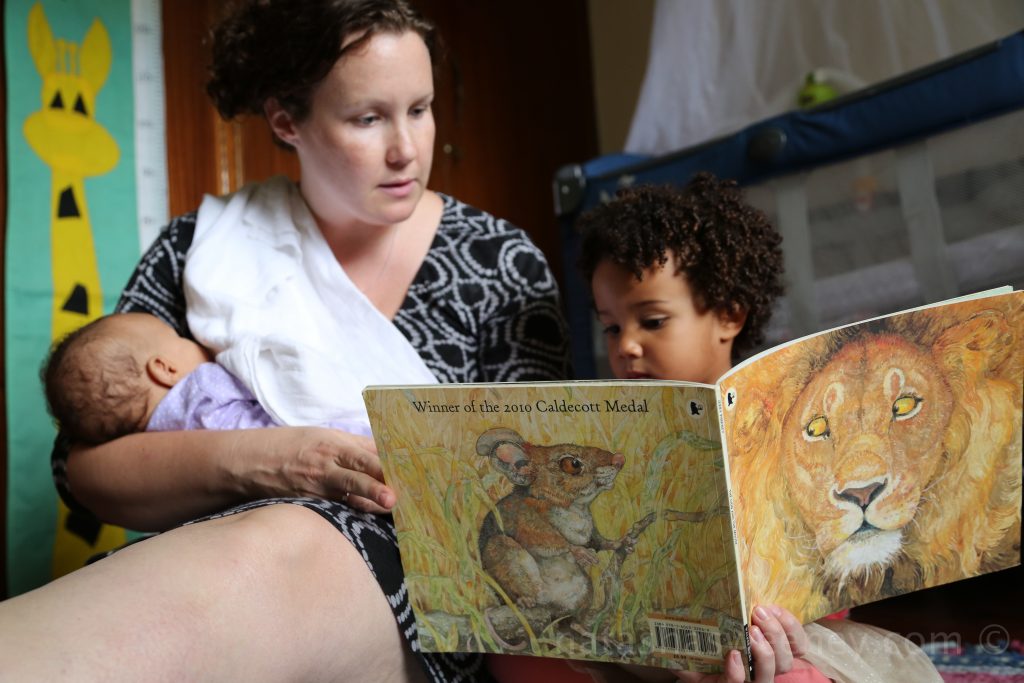
Safari ya Angani, by Francis Atulo
This is a story of the once-beautiful tortoise who wished to fly with the crows into the sky to eat the clouds. One day, the crows carry him up into the sky, as the tortoise sings, “Tunaenda kula mawingu,” (We’re going to eat the clouds!). But the crows lose their grip, and the tortoise falls down to Earth, landing on his back and cracking his beautiful shell. This story is told in simple Kiswahili, and our girls love to sing with the tortoise!
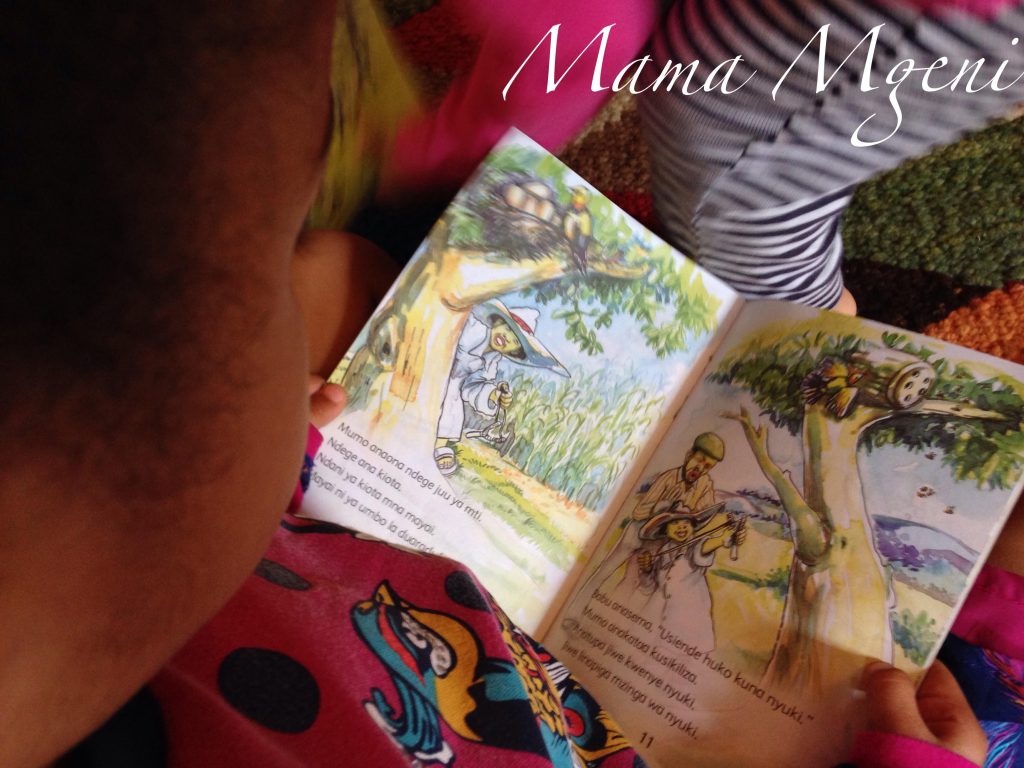
Opulo Aenda Safari by Frank Odoi
The story of a rat named Opulo, who used to have a beautiful, fluffy tail and a nice Maasai blanket to wear on his shoulder. But Opulo is stubborn, and he refuses advice from friends when he sets off on a journey. He winds up walking straight into a thunderstorm, and ultimately loses both his beautiful clothing and his fluffy tail, and learns an important lesson.
Shambani kwa Babu by Hassan Makombo
The story of a young boy named Mumo who goes to the village to visit his grandparents. While helping his grandfather in the garden, he shoots at a bird’s nest with his slingshot, and disturbs a nest of bees. His wise grandfather quickly fans the fire, and uses the smoke to chase away the bees, and Mumo learns an important lesson.
We want our children to see themselves in the books we read, and these tales of life in Kenya definitely give our kids a chance to identify with their Kenyan culture and heritage. Since we live in Nairobi, the capital city of Kenya, our girls aren’t always exposed to traditional life in the rural villages. We love the traditional tales spun in these stories!
Do you read your children stories about their native country and culture? What are your favorites?
This is an original post to World Moms Blog by Tara Wambugu. Follow Tara and her family’s adventures on her blog, Mama Mgeni, and connect with her on Facebook and Twitter.
Photos for The Lion and the Mouse by Natasha Sweeney, used with permission. All other photos credited to the author.
Tara Wambugu is a wife, a mother of two, and a Kenya-based lifestyle blogger covering parenting, family life, travel, and more. A former aid worker, Tara has worked in various countries in Europe, Central Asia, Africa, and Central America. She is now a stay-at-home mom living in Nairobi with her husband and their two sassy little girls. You can follow Tara and her family’s adventures on her blog, Mama Mgeni.
More Posts - Website
Follow Me:






by Jennifer Burden | Feb 9, 2016 | 2015, 2016, Asia, Maternal Health, Mission Motherhood, Tina Santiago-Rodriguez
 As part of World Moms Blog’s collaboration with BabyCenter’s Mission Motherhood™, our World Moms are writing posts on maternal health around the world. In today’s post, Tina Santiago-Rodriguez in the Philippines writes about milk sharing after Typhoon Haiyan (Yolanda) to help moms in need.
As part of World Moms Blog’s collaboration with BabyCenter’s Mission Motherhood™, our World Moms are writing posts on maternal health around the world. In today’s post, Tina Santiago-Rodriguez in the Philippines writes about milk sharing after Typhoon Haiyan (Yolanda) to help moms in need.
“My heart cried out at their unbearable situation, and I told myself I had to do something about it. By nature, I like helping people, so I felt that donating my milk was the right thing to do. I sent all my milk reserves to Ms. Maricel and Ms. Beng’s MilkSharing Hub, and told Ms. Maricel to distribute them to the needy babies in Tacloban.”
Read the full post over at BabyCenter’s Mission Motherhood™!

Jennifer Burden is the Founder and CEO of World Moms Network, an award winning website on global motherhood, culture, human rights and social good. World Moms Network writes from over 30 countries, has over 70 contributors and was listed by Forbes as one of the “Best 100 Websites for Women”, named a “must read” by The New York Times, and was recommended by The Times of India.
She was also invited to Uganda to view UNICEF’s family health programs with Shot@Life and was previously named a “Global Influencer Fellow” and “Social Media Fellow” by the UN Foundation. Jennifer was invited to the White House twice, including as a nominated "Changemaker" for the State of the World Women Summit. She also participated in the One Campaign’s first AYA Summit on the topic of women and girl empowerment and organized and spoke on an international panel at the World Bank in Washington, DC on the importance of a universal education for all girls. Her writing has been featured by Baby Center, Huffington Post, ONE.org, the UN Foundation’s Shot@Life, and The Gates Foundation’s “Impatient Optimists.” She is currently a candidate in Columbia University's School of International and Public Affairs in the Executive Masters of Public Affairs program, where she hopes to further her study of global policies affecting women and girls.
Jennifer can be found on Twitter @JenniferBurden.
More Posts - Website
Follow Me:


by World Moms Blog | Feb 9, 2016 | 2016, Asia, Birthing, Clean Birth Kits, Ewa Samples, Humanitarian, International, Maternal Health, World Moms Blog, World Voice
World Moms Blog has been supporting the mission of CleanBirth.org, founded by contributor Krysin Zalota, from the beginning. After all, we are a group of moms here, so it has made us even more compassionate to the need for safe, sterile birth for the sake of both babies and their mamas. In the villages where Cleanbirth.org operates women traditionally give birth alone in the forest. Laos has one of the highest maternal mortality rates in the region.
You can follow our fundraising efforts and join in — only $5 provides a clean birth kit! — here: http://cleanbirth.causevox.com/world-moms-blog. We’ve already raised $490! Please help us break $500!
In 2015, its third full year of operation, Cleanbirth.org has provided 1,179 moms in the program in Laos with clean births, where there were zero reports of infections and where 170 nurses were trained. We continue to support the organization and maternal health worldwide, not just on the World Moms Blog site, but on many of our personal blogs, as well. Here are a few of the blog posts and campaigns that World Moms contributors have launched this year around Cleanbirth.org.

This May, Ewa Samples from Ewa Samples Photography and CleanBirth are coming together for a second edition of a Mother’s Day Campaign to raise funds to help moms in Laos together.
Last year they were able to raise almost $600 in two days! This year, they invite everyone in the Bay Area, California, to join in to support this wonderful cause.
Ewa will be offering special packages for family photography sessions, where part of the profit will be donated to CleanBirth.
Our Managing Editor, Elizabeth Atalay, in Rhode Island, USA wrote about Cleanbirth.org this month on her blog, Documama:
$5.00 Can Save 2 Lives With CleanBirth.org
Over in the United Arab Emirates, World Mom, KC of Mummy in Transit, also wrote about why helping make births safer in Laos is important to her!:
http://www.mummyintransit.com/2016/01/28/maternal-care-around-the-world/
Nicole Melancon did this fantastic interview with Clean Birth Founder Kristyn Zalota in 2015:
One Mom’s Quest to Save Mother’s Lives in Laos
Sophia of ThinkSayBe shared her birth stories in support of Cleanbirth.org this year:
“Reading about what CleanBirth.org definitely made me assess my own pregnancies and the access we (my babies and I) had to clean and modern facilities in case of emergencies during the pregnancy, and for a safe delivery to my babies and myself.”
https://thinksaybe.wordpress.com/2016/01/29/mahood-a-mothers-story-of-maternal-care/
And, here is our post on World Moms Blog introducing the kick off of the Cleanbirth.org campaign!
http://www.worldmomsblog.com/2016/01/26/world-voice-a-small-pink-bag-a-nurse-and-you/
This is an original post to World Moms Blog.
*We apologize for the choppy first version of this post that was published. Our editors were facing technical difficulties!
World Moms Blog is an award winning website which writes from over 30 countries on the topics of motherhood, culture, human rights and social good. Over 70 international contributors share their stories from around the globe, bonded by the common thread of motherhood and wanting a better world for their children.
World Moms Blog was listed by Forbes Woman as one of the "Best 100 Websites for Women 2012 & 2013" and also called a "must read" by the NY Times Motherlode in 2013. Our Senior Editor in India, Purnima Ramakrishnan, was awarded the BlogHer International Activist Award in 2013.
More Posts

by Mannahattamamma (UAE) | Feb 8, 2016 | 2016, Adolescence, Boys, Family, Humor, Middle East, Older Children, Parenting, Teenagers, UAE, USA
 Frequently I am embarrassed by the fact that I only speak one language. Many of my friends in Abu Dhabi speak at least two, and most of my students speak three or even four. A few years ago I tried to learn Arabic and was stymied by a simple fact: my brain is old. It’s that whole “old dog new tricks” thing, which is to say, my brain wanted nothing to do with new lexical and grammatical systems.
Frequently I am embarrassed by the fact that I only speak one language. Many of my friends in Abu Dhabi speak at least two, and most of my students speak three or even four. A few years ago I tried to learn Arabic and was stymied by a simple fact: my brain is old. It’s that whole “old dog new tricks” thing, which is to say, my brain wanted nothing to do with new lexical and grammatical systems.
Lately, however, I’ve been confronted with another new language and it’s proving equally difficult to master. In fact, maybe I will never master it.
It’s the language spoken by fifteen-year old boys in the twenty-first century in a first-world city. It’s both a spoken and a written language, comprised of monosyllables, grunts, emojis, and weird snapchat abbreviations. It’s a language that his friends speak fluently and one that he never deigns to translate to us, his parents.
Let me be clear: my son is the proverbial “good kid,” who still (occasionally) sits on my lap (usually when he wants a favor), does his homework without being asked, and is (sometimes) nice to his younger brother. But beyond that?
We get commentary about his basic human needs—food, sleep, wi-fi—and then he retreats into his digitally created iCocoon.
When I look at my son these days, the air seems full of ghosts; it’s like I’m seeing time, compressed and wispy, floating between the two of us. I see his baby self, staggering around the house with mushy graham crackers clenched in each fist, and I see other snippets of his childhood, too, hovering just beyond his (increasingly broad) shoulders. And at the same time, there’s the ghost of my own teenage self, snarling at my mother (sorry mom!) as I stand by the phone, willing The Cute Boy to call me.
The phone is a key difference in this linguistic and generational incomprehension. Those of you of a certain age will remember the days when houses had those things we now call “land lines,” which were anchored in a specific place and were frequently shared by the entire household. That meant that your TOTALLY ANNOYING younger siblings could pick up another extension and a) eavesdrop on your conversation; b) tell your mom what you were talking about; c) tease you mercilessly while you tried to be cool with The Cute Boy on the other end of the line.
Now, however, my son and his teenage friends carry a scrim of adolescence with them at all times, an endless stream of chitterchatter, gossip, sports scores, vaguely obscene quizzes, and god knows what else. Did you know it’s possible to have a scintillating conversation conducted entirely in poop and unicorn emojis, with the occasional emoti-face thrown in for good measure? It’s as if teenagers have all been transported into an ancient Egyptian civilzation and are fluent in hieroglyphs—yet another language I do not speak.
As I think about it, I am not sure, really, whether it’s that my son and I are speaking different languages or that his other language is omnipresent in a way that my teenspeak was not, because technology didn’t let it happen.
At some point I had to hang up the phone and turn off the TV, and engage with my family. Mind you, I wasn’t necessarily pleased about those engagements, but the world of “non-family” was regularly shut off.
Now, with smart phones, the external world is always ready to hand; there is always a way to tune out the family world.
I can hear you all, shaking your heads and muttering that we should set some boundaries and be firm about your expectations and teach your kid some manners and I bet that some of you, with small children, are thinking “my children won’t ever…”
Here’s the thing: I’ve thought all those things too. But then one night my son became fifteen and the battle lines got redrawn. How many times can we argue about how much phone use is too much; how many times can we discuss “reasonable use?” My son insists that I am the only parent who nags about such things, but my totally unscientific research suggests otherwise. I’ve talked with friends from Europe, Africa, the States, and elsewhere in the Middle East, and the screen-time battle seems to be an almost universal parenting problem.
If I think about it, the translation problems run in two directions. If my son could speak “parent,” then he would understand that in my repeated (and to him unreasonable) requests that he turn off his phone and talk to me, I am really saying “don’t grow up so fast, please don’t be in such a hurry to leave us behind.” He would understand that watching him grow up is lovely — and ineffably sad.
Maybe he’d understand if I put it in snapchat-ese for him. Can anyone translate into emoji for me?
How are things different now from when you were a teen? Do you find that the teens of today speak a different language?
This is an original post to World Moms Blog by Deborah Quinn, Mannahattamamma of the UAE. Photo credit to the author.
After twenty-plus years in Manhattan, Deborah Quinn and her family moved to Abu Dhabi (in the United Arab Emirates), where she spends a great deal of time driving her sons back and forth to soccer practice. She writes about travel, politics, feminism, education, and the absurdities of living in a place where temperatures regularly go above 110F.
Deborah can also be found on her blog, Mannahattamamma.
More Posts
Follow Me:


by Tara Bergman (USA) | Feb 5, 2016 | 2016, Mental Health, Nature, North America, Tara B., USA, Womanhood, World Moms Blog, World Motherhood

It’s been the kind of month in which the worn down clasp on my emotional baggage has popped open, spilling years of contents everywhere in disarray. I have been methodically working through the cleanup, but today, I felt the need to wander in nature for a mental health break.
I walked out the door with my furry companion, an amazing golden retriever who is the best dang dog who ever lived. Seriously, she’s awesome. I usually like to map out our adventures a bit more, but I didn’t have the reserves to make up my mind on where to go, so I decided to just leave the house and see where we would end up. (more…)
Tara is a native Pennsylvanian who moved to the Seattle area in 1998 (sight unseen) with her husband to start their grand life adventure together. Despite the difficult fact that their family is a plane ride away, the couple fell in love with the Pacific Northwest and have put down roots. They have 2 super charged little boys and recently moved out of the Seattle suburbs further east into the country, trading in a Starbucks on every corner for coyotes in the backyard. Tara loves the outdoors (hiking, biking, camping). And, when her family isn't out in nature, they are hunkered down at home with friends, sharing a meal, playing games, and generally having fun. She loves being a stay-at-home mom and sharing her experiences on World Moms Network!
More Posts



















 As part of World Moms Blog’s
As part of World Moms Blog’s 


 Frequently I am embarrassed by the fact that I only speak one language. Many of my friends in Abu Dhabi speak at least two, and most of my students speak three or even four. A few years ago I tried to learn Arabic and was stymied by a simple fact: my brain is old. It’s that whole “old dog new tricks” thing, which is to say, my brain wanted nothing to do with new lexical and grammatical systems.
Frequently I am embarrassed by the fact that I only speak one language. Many of my friends in Abu Dhabi speak at least two, and most of my students speak three or even four. A few years ago I tried to learn Arabic and was stymied by a simple fact: my brain is old. It’s that whole “old dog new tricks” thing, which is to say, my brain wanted nothing to do with new lexical and grammatical systems.




